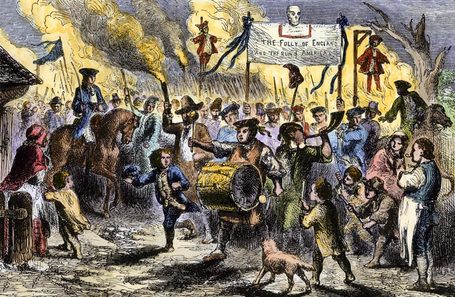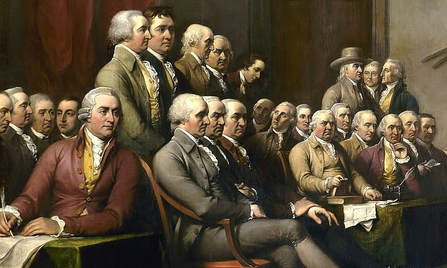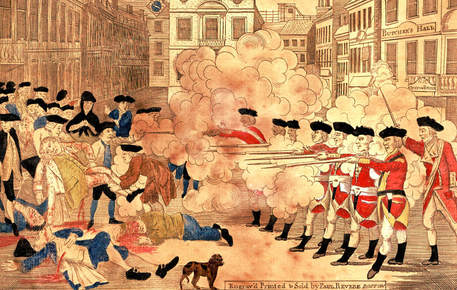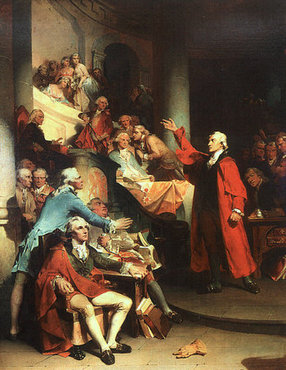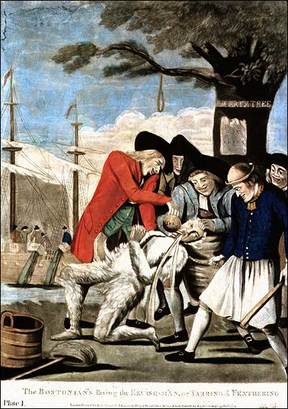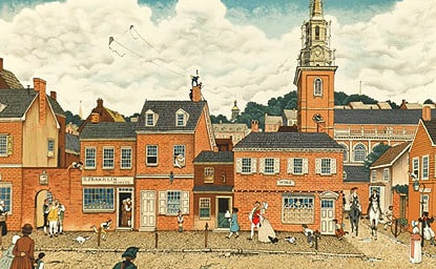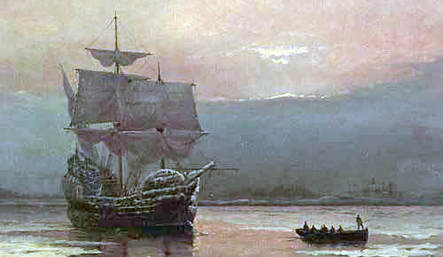|
Content Standards:
Students will analyze how history is a series of connected events shaped by multiple cause and effect relationships, tying past to present. Learning Target: I can summarize the social, political, and economic factors that drove the American colonies to independence. Critical Vocabulary: King George III, Albany Plan of Union, Treaty of Paris, Proclamation of 1763, Writs of Assistance, Sugar Act, Stamp Act, Quartering Act, Stamp Act Congress, Sons of Liberty, Boston Massacre, Captain Thomas Preston, Crispus Attucks, Tea Act, Boston Tea Party, Intolerable Acts, First Continental Congress, Second Continental Congress, Lexington and Concord, Continental Army, George Washington,Thomas Paine, Common Sense, Thomas Jefferson Today's Agenda:
Homework: Tentative Test Date: September 8
0 Comments
Content Standards:
Students will analyze how history is a series of connected events shaped by multiple cause and effect relationships, tying past to present. Learning Target: I can summarize the social, political, and economic factors that drove the American colonies to independence. Critical Vocabulary: King George III, Albany Plan of Union, Treaty of Paris, Proclamation of 1763, Writs of Assistance, Sugar Act, Stamp Act, Quartering Act, Stamp Act Congress, Sons of Liberty, Boston Massacre, Captain Thomas Preston, Crispus Attucks, Tea Act, Boston Tea Party, Intolerable Acts, First Continental Congress, Second Continental Congress, Lexington and Concord, Continental Army, George Washington,Thomas Paine, Common Sense, Thomas Jefferson Today's Agenda:
Homework: Tentative Test Date: September 8 Content Standards:
Students will analyze how history is a series of connected events shaped by multiple cause and effect relationships, tying past to present. Learning Target: I can summarize the social, political, and economic factors that drove the American colonies to independence. Critical Vocabulary: King George III, Albany Plan of Union, Treaty of Paris, Proclamation of 1763, Writs of Assistance, Sugar Act, Stamp Act, Quartering Act, Stamp Act Congress, Sons of Liberty, Boston Massacre, Captain Thomas Preston, Crispus Attucks, Tea Act, Boston Tea Party, Intolerable Acts, First Continental Congress, Second Continental Congress, Lexington and Concord, Continental Army, George Washington,Thomas Paine, Common Sense, Thomas Jefferson Today's Agenda:
Homework: Tentative Test Date: September 8 Content Standards:
Students will analyze how history is a series of connected events shaped by multiple cause and effect relationships, tying past to present. Learning Target: I can summarize the social, political, and economic factors that drove the American colonies to independence. Critical Vocabulary: King George III, Albany Plan of Union, Treaty of Paris, Proclamation of 1763, Writs of Assistance, Sugar Act, Stamp Act, Quartering Act, Stamp Act Congress, Sons of Liberty, Boston Massacre, Captain Thomas Preston, Crispus Attucks, Tea Act, Boston Tea Party, Intolerable Acts, First Continental Congress, Second Continental Congress, Lexington and Concord, Continental Army, George Washington,Thomas Paine, Common Sense, Thomas Jefferson Today's Agenda:
Homework: The Road to Revolution Questions Tentative Test Date: September 8 Content Standards:
Students will analyze how history is a series of connected events shaped by multiple cause and effect relationships, tying past to present. Learning Target: I can summarize the social, political, and economic factors that drove the American colonies to independence. Critical Vocabulary: King George III, Albany Plan of Union, Treaty of Paris, Proclamation of 1763, Writs of Assistance, Sugar Act, Stamp Act, Quartering Act, Stamp Act Congress, Sons of Liberty, Boston Massacre, Captain Thomas Preston, Crispus Attucks, Tea Act, Boston Tea Party, Intolerable Acts, First Continental Congress, Second Continental Congress, Lexington and Concord, Continental Army, George Washington,Thomas Paine, Common Sense, Thomas Jefferson Today's Agenda:
Homework: The Road to Revolution Questions Tentative Test Date: September 8 Content Standards:
Students will analyze how history is a series of connected events shaped by multiple cause and effect relationships, tying past to present. Learning Target: I can summarize the social, political, and economic factors that drove the American colonies to independence. Critical Vocabulary: King George III, Albany Plan of Union, Treaty of Paris, Proclamation of 1763, Writs of Assistance, Sugar Act, Stamp Act, Quartering Act, Stamp Act Congress, Sons of Liberty, Boston Massacre, Captain Thomas Preston, Crispus Attucks, Tea Act, Boston Tea Party, Intolerable Acts, First Continental Congress, Second Continental Congress, Lexington and Concord, Continental Army, George Washington,Thomas Paine, Common Sense, Thomas Jefferson Today's Agenda:
Homework: The Road to Revolution Questions Tentative Test Date: September 8 Content Standards:
Students will analyze how history is a series of connected events shaped by multiple cause and effect relationships, tying past to present. Learning Target: I can summarize the social, political, and economic factors that drove the American colonies to independence. Critical Vocabulary: King George III, Albany Plan of Union, Treaty of Paris, Proclamation of 1763, Writs of Assistance, Sugar Act, Stamp Act, Quartering Act, Stamp Act Congress, Sons of Liberty, Boston Massacre, Captain Thomas Preston, Crispus Attucks, Tea Act, Boston Tea Party, Intolerable Acts, First Continental Congress, Second Continental Congress, Lexington and Concord, Continental Army, George Washington,Thomas Paine, Common Sense, Thomas Jefferson Today's Agenda:
Homework: The Road to Revolution Questions Tentative Test Date: September 1 Content Standards:
Students will analyze how history is a series of connected events shaped by multiple cause and effect relationships, tying past to present. Learning Target: I can summarize the social, political, and economic factors that drove the American colonies to independence. Critical Vocabulary: King George III, Albany Plan of Union, Treaty of Paris, Proclamation of 1763, Writs of Assistance, Sugar Act, Stamp Act, Quartering Act, Stamp Act Congress, Sons of Liberty, Boston Massacre, Captain Thomas Preston, Crispus Attucks, Tea Act, Boston Tea Party, Intolerable Acts, First Continental Congress, Second Continental Congress, Lexington and Concord, Continental Army, George Washington,Thomas Paine, Common Sense, Thomas Jefferson Today's Agenda:
Homework: The Road to Revolution Questions Tentative Test Date: September 1 Content Standards:
Students will analyze how history is a series of connected events shaped by multiple cause and effect relationships, tying past to present. Learning Target: I can compare and contrast the societies that developed in the 13 English colonies, and I can predict the problems that might arise from these differences. Critical Vocabulary: Henry Hudson, New Netherland, Peter Minuit, Peter Stuyvesant, Dutch West India Company, William Penn, Quakers, Philadelphia, Benjamin Franklin, New Sweden Today's Agenda:
Homework: Notebook Cover Page Tentative Test Date: September 1 Content Standards:
Students will analyze how history is a series of connected events shaped by multiple cause and effect relationships, tying past to present. Learning Target: I can compare and contrast the societies that developed in the 13 English colonies, and I can predict the problems that might arise from these differences. Critical Vocabulary: Pilgrims, Plymouth Bay, Mayflower Compact, William Bradford, Squanto, Massachusetts Bay Company, John Winthrop, “A Model of Christian Charity,” Harvard College, Roger Williams, Anne Hutchinson, Thomas Hooker, Fundamental Orders of Connecticut, Pequot War, King Philip, King Philip’s War Today's Agenda:
Homework: Notebook Cover Page Tentative Test Date: September 1 |
History, although sometimes made up of the few acts of the great, is more often shaped by the many acts of the small.
-Mark Twain AnnouncementsMay 4: No School ResourcesArchives
May 2018
Visitors |
